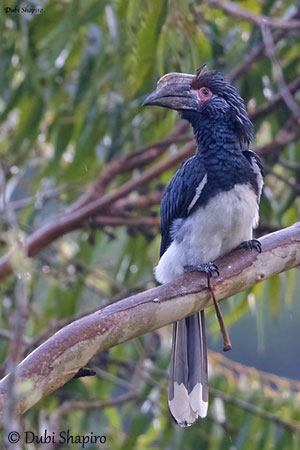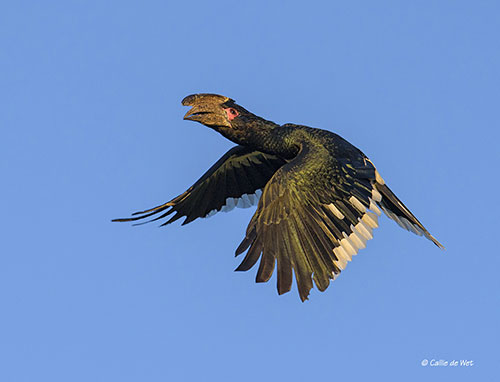
Fr: Calao trompette
Ang: Trumpeter Hornbill
All: Trompeterhornvogel
Esp: Cálao Trompetero
Ita: Bucero trombettiere
Nd: Trompetneushoornvogel
Sd: trumpetarnäshornsfågel
Photographers:
Callie de Wet
GALLERY
Steve Garvie
RAINBIRDER Photo galleries & Flickr Rainbirder
Dubi Shapiro
Dubi Shapiro Photo Galleries
Text by Nicole Bouglouan
Sources:
HANDBOOK OF THE BIRDS OF THE WORLD Vol 6 by Josep del Hoyo-Andrew Elliott-Jordi Sargatal - Lynx Edicions, 2001 - ISBN: 848733430X
BIRDS OF AFRICA SOUTH OF THE SAHARA by Ian Sinclair and Peter Ryan - Princeton University Press Princeton and Oxford - ISBN: 0691118159
Birds of Kenya's Rift Valley De Adam Scott Kennedy - Princeton University Press, 2014 – ISBN: 1400851378, 9781400851379 – 256 pages
Aspects of the ecology of Trumpeter Hornbill (Bycanistes bucinator) across urban-forest mosaics in KwaZulu-Natal, South Africa
Wikipedia, the free encyclopaedia
Trumpeter Hornbill
Bycanistes bucinator
Bucerotiformes Order – Bucerotidae Family
INTRODUCTION:
The Trumpeter Hornbill occurs from Kenya to Angola and to eastern half of Southern Africa. It is found in coastal lowland forest, evergreen forests and tall deciduous woodlands. It feeds on several fruits, small animals, small birds, insects and other invertebrates, while foraging among the tree foliage.
Like most Hornbills, it nests in natural cavities closed with mud by both mates during incubation and chick rearing. The male provides food during this period.
The Trumpeter Hornbill is a black and white, medium-sized hornbill. It has a large, black bill with conspicuous casque.
This species is described as locally common, but it is affected by habitat loss. However, it is not globally threatened for the moment.

DESCRIPTION OF THE BIRD:
Biometrics:
Length: 58-65 cm
Wingspan: 61 cm
Weight: M: 607-941 g (720g) – F: 452-670 g (565g)
The Trumpeter Hornbill has black and white plumage. Head, neck, upper breast, back, wings and tail are black with bronzy sheen. Lower rump, uppertail-coverts, lower breast, belly, vent and underwing coverts are white.
On the wings, both secondaries and inner primaries show conspicuous white tips, especially visible in flight. The long tail shows broad, white terminal band, except on central rectrices.
On the underwings, the coverts are white.
On the black head, the male has black bill and pronounced casque, the latter extending almost to the tip of the bill.
The dark brown eyes are surrounded by red/purple bare skin.
Legs and feet are brownish.
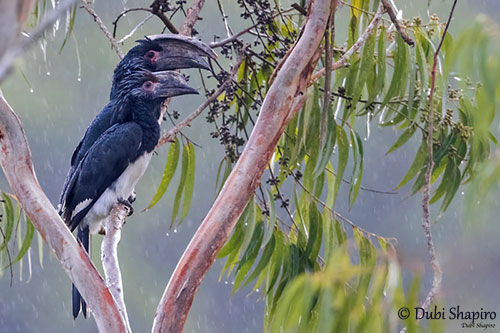
The female has similar plumage but she is smaller, with much smaller casque. The bill has yellowish base and tip.
The juvenile resembles adults but there is no casque on the bill, and the feathers of the face are brown-tipped, including at bill base.
RANGE:
The Trumpeter Hornbill is found in the eastern half of Southern Africa, from N and NE Angola and South DRCongo, across to S Kenya, then S to NE Namibia (Caprivi Strip), N Botswana, E Zimbabwe and E and SE South Africa.
HABITAT:
The Trumpeter Hornbill frequents warm evergreen forests, especially coastal and riverine forests. It is also observed in deciduous woodlands, and may reach the wooded hillsides. The species is visible up to 2,200 metres of elevation.
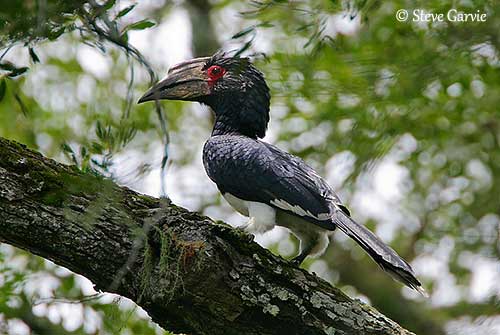
CALLS AND SONGS: SOUNDS BY XENO-CANTO
The Trumpeter Hornbill vocalizes loudly and produces drawn out nasal calls “waaah…waaah…” very similar to the crying of a child. Loud braying calls are given in flight.
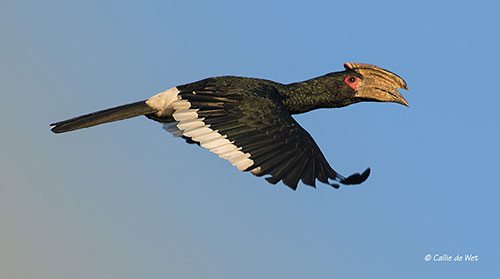
BEHAVIOUR IN THE WILD:
The Trumpeter Hornbill is omnivorous. Its diet consists of various fruits, especially figs and Trichilia (Meliaceae family), large insects, crabs, millipedes, reptiles, small mammals, small birds, eggs and nestlings.
It may spend the whole day in a single fruiting tree, foraging among branches and foliage. It also rests in the dense cover near the foraging trees.
It usually moves to another feeding site the next day. It is able to fly about 10 kilometres over the savanna and between woodland patches, in search of fruiting trees.
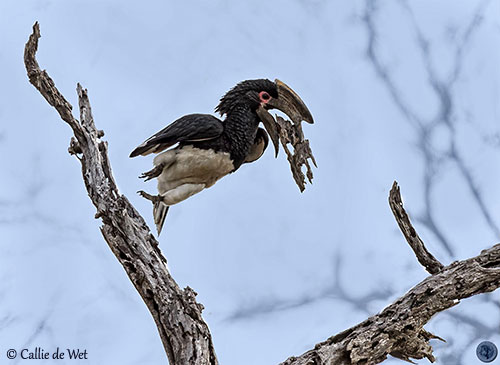
Like most Hornbills, the Trumpeter Hornbill nests in natural cavity. During the breeding cycle, the female encloses herself (with some help from the male) in the cavity where she lays the eggs and incubates. The male provides her all the food during this period.
The species is presumed to be monogamous, but sometimes, a second male or young of the previous year may assist the pair as helper. Both mates remain together for life. They move in pairs during the breeding season, whereas large flocks of adults and juveniles can be seen outside this period.
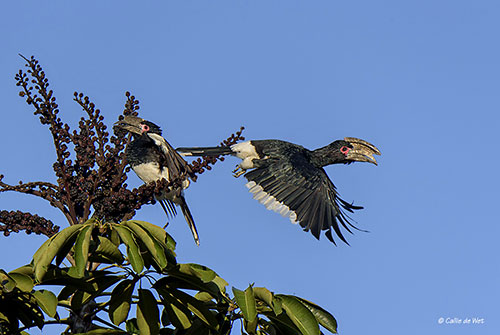
The Trumpeter Hornbill is mostly resident, but it moves regularly while searching for new fruiting trees. They usually cover distances of 10-15 kilometres when visiting numerous forest patches.
Numerous Hornbills fly with rather slow, deep wingbeats, often interspersed with short glides.
During the flight of the larger species, the wingbeats produce a loud whooshing noise audible at a distance.
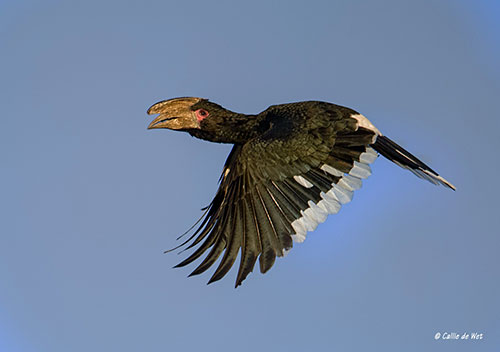
REPRODUCTION OF THIS SPECIES:
The laying period takes place between September and January.
The Trumpeter Hornbill nests in natural cavity, a hole in tree or less often in high rock face. The nesting site is selected by the female. The cavity is lined with bark and wood flakes. Then, both male and female seal the nest entrance with mud, faeces and saliva. The male regurgitates mud pellets or carries them in the large bill. They only leave a small slit.
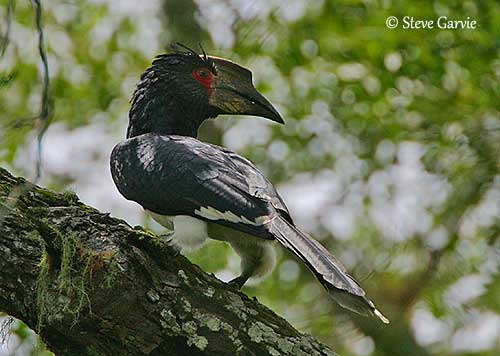
The female lays 2-4 eggs and incubates during 24-28 days. The male forages for the female and gives her food items through the entrance slit. When the chicks hatch, the male may regurgitate up to 38 food items per visit.
While in the nest, the female moults rectrices and flight-feathers. She emerges when the chicks fledge, at least 50 days after hatching. Then, the chicks stay near the nest during a week, before joining their parents for foraging. They remain about six months with their parents.
The female stays in the nest during about 90-95 days, from the pre-laying period to the fledging period.
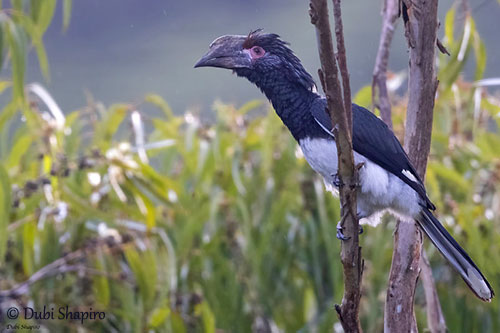
PROTECTION / THREATS / STATUS:
The Trumpeter Hornbill is described as locally common in several areas within the wide range.
This species is threatened by habitat loss, international trade and possibly hunting. Habitat loss is caused by urbanization that degrades the natural habitats. The species is forced to live in reduced ranges, but it persists and uses the urban-forest mosaic.
The size of the population in currently unknown, but it is suspected to be declining, although being considered not globally threatened.
The Trumpeter Hornbill is currently evaluated as Least Concern.
